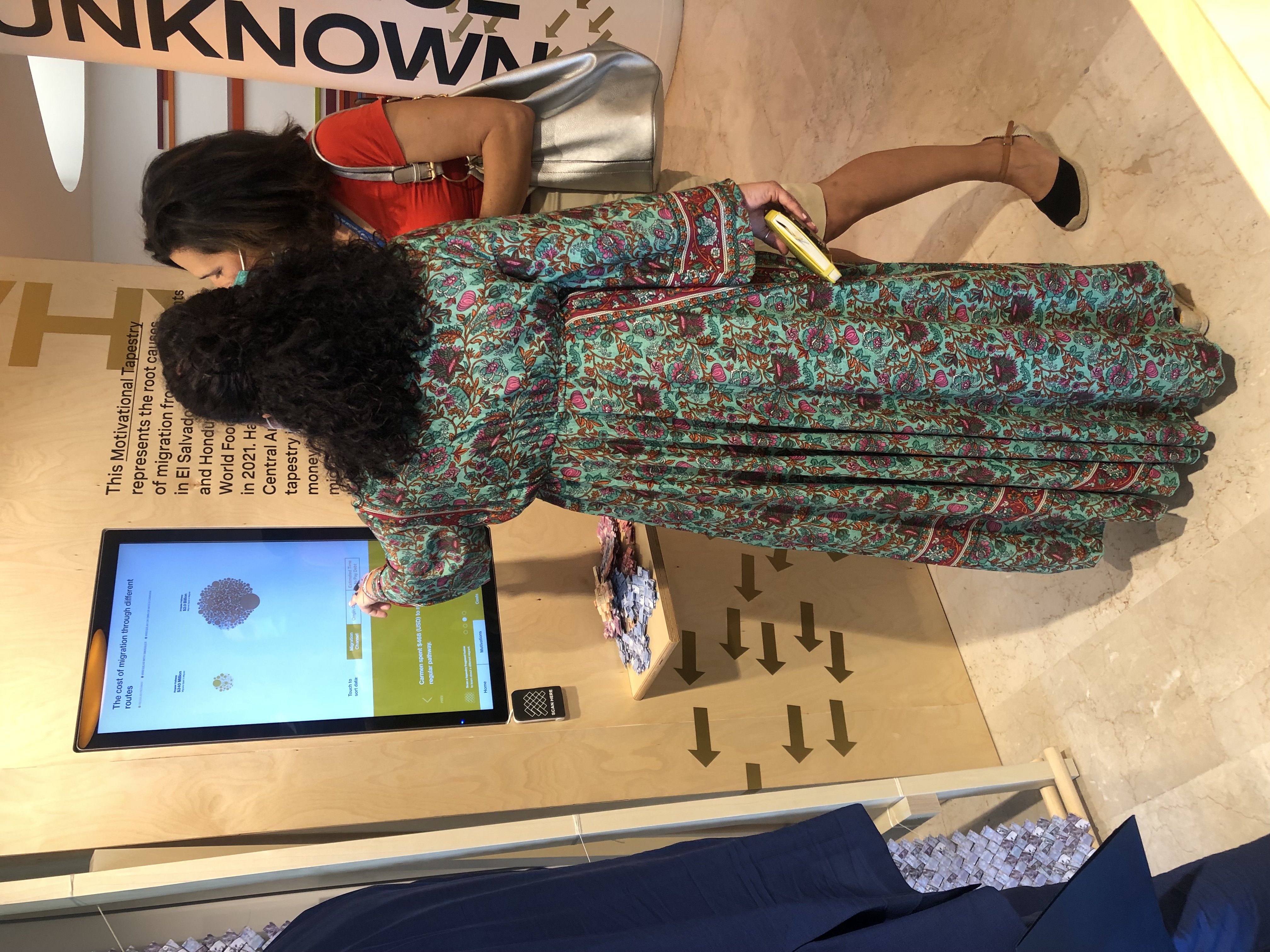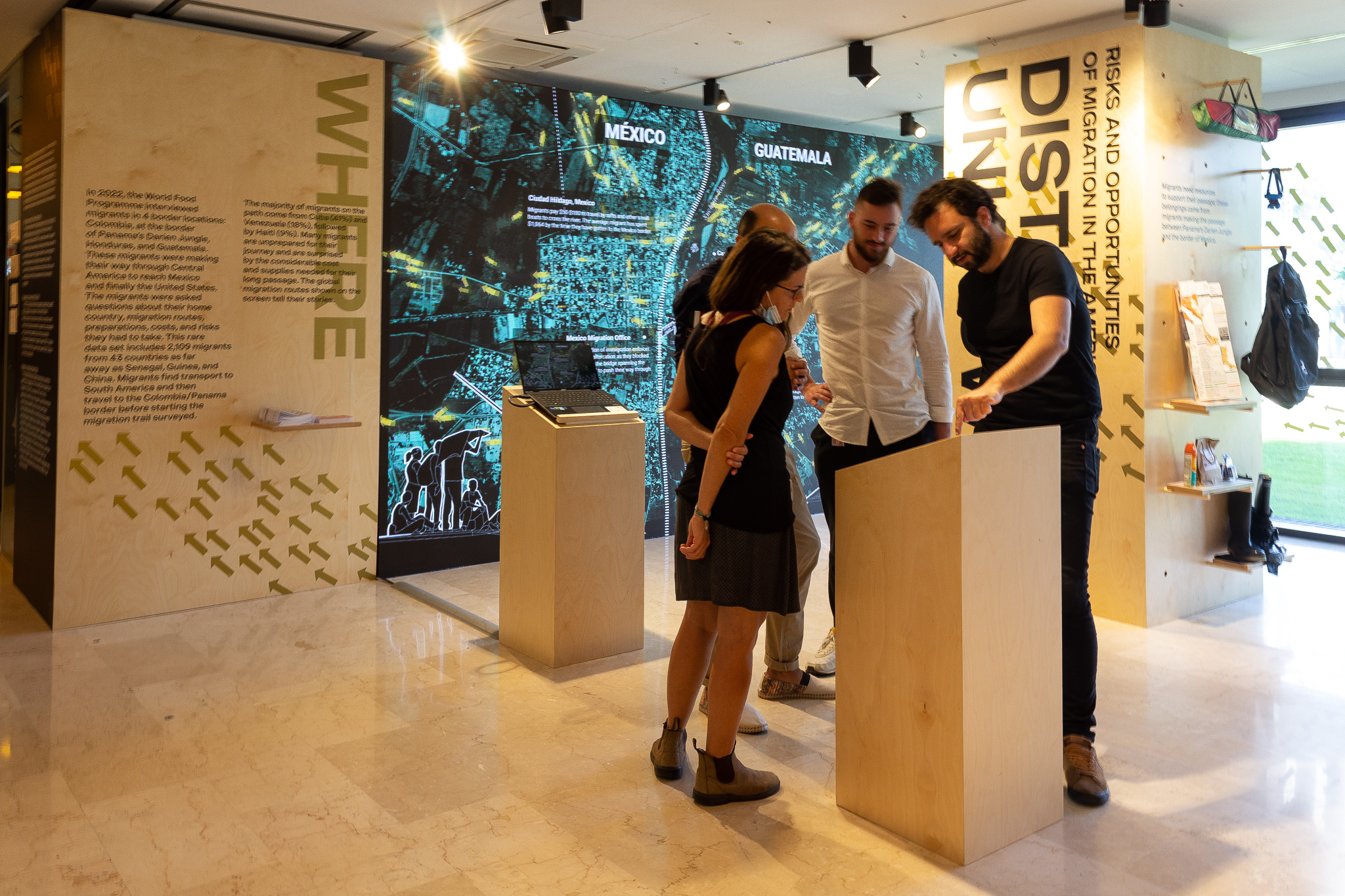June 22, 2022
ROME, ITALY: A group of UN ambassadors, national representatives, their aides, and WFP employees gathered in the Red Foyer of the UN World Food Programme (WFP) headquarters to see the opening of an exhibition on migration in the Americas. The exhibition, DISTANCE UNKNOWN, was on display between June 20-24, 2022 during the week of the WFP Executive Board, where the member states of the United Nations and member nations of the Food and Agriculture Organization of the United Nations (FAO) annually meet to provide intergovernmental support, policy direction and supervision of the activities of WFP.
DISTANCE UNKNOWN is an exhibition by the Civic Data Design Lab at MIT (CDDL) and the World Food Programme (WFP) that tells stories of the risks and opportunities of migration in the Americas. The exhibition is built from data collected from 4,998 households surveyed by WFP in El Salvador, Guatemala, and Honduras in 2021 and from 2,109 migrants from 43 countries interviewed at four border locations between Colombia and Guatemala. The exhibition features both digital and physical data visualizations that encourage visitors to follow migrants’ journeys through an interactive map and investigate migrants’ motivations with a woven tapestry.
![Lola Castro, WFP Regional Director of Latin America and the Caribbean, introduces speakers for opening remarks]()
!["... but when people have to migrate because they have no choice, it creates political problems on all sides" - David Beasley, WFP Executive Director]()
![Ana Luisa Castro Novey, Vice-Minister of Multilateral Affairs and Cooperation of Panama, leads on how international partnerships can help provide migrants with health coverage, food, shelter, and security]()
!["We can't postpone this kind of discussion," Carlos Cherniak, Ambassador of Argentina, urges colleagues at the Executive Board to work together towards actionable solutions]()
![Sarah Williams, Director of Civic Data Design Lab at MIT, introduces the data visualizations on display and how CDDL's research "can make the insights of data more human and accessible to policy makers"]() During the opening remarks to the exhibition, David Beasley, Executive Director of WFP, explained that “when people have to migrate because they have no choice, it creates political problems on all sides,” and emphasized the importance of proposing solutions. Beasley also cited that migrants from El Salvador, Guatemala, and Honduras collectively spent $2.2 billion dollars to migrate to the United States in 2021, which is comparable to what their respective governments spend on primary education, a figure referenced from Charting a New Regional Course of Action: The Complex Motivations and Costs of Migration in Central America, a joint report launched in November 2021 by the UN World Food Programme, MIT Civic Data Design Lab, and the Migration Policy Institute.
During the opening remarks to the exhibition, David Beasley, Executive Director of WFP, explained that “when people have to migrate because they have no choice, it creates political problems on all sides,” and emphasized the importance of proposing solutions. Beasley also cited that migrants from El Salvador, Guatemala, and Honduras collectively spent $2.2 billion dollars to migrate to the United States in 2021, which is comparable to what their respective governments spend on primary education, a figure referenced from Charting a New Regional Course of Action: The Complex Motivations and Costs of Migration in Central America, a joint report launched in November 2021 by the UN World Food Programme, MIT Civic Data Design Lab, and the Migration Policy Institute.
![]()
![]()
On one side of the exhibition, a vibrant tapestry made of “migrant money” visualizes the root causes of migration from Central American migrants. This tapestry was handwoven by 13 Latin American migrants, and each square fragment represents one migrant’s motivation: economic, quality of life, reunification, security, and climate change. Visitors can pick up a fragment of the tapestry and scan it at a touch screen station to learn more about why the migrant left home, their household circumstances, and more about their personal story.
![]()
![]() Civic Data Design Lab researchers, Ashley Louie, Niko McGlashan, and Alberto Meouchi explain research findings and how to explore the data visualizations.
Civic Data Design Lab researchers, Ashley Louie, Niko McGlashan, and Alberto Meouchi explain research findings and how to explore the data visualizations.
An interactive map on the opposite side of the exhibition allows visitors to explore the journeys and barriers that migrants face along the way. The map highlights the Darien region as one of the most dangerous and costly parts of the journey. In response to the increased migration through the Darien in 2019, the Panamanian Government began providing migrants with temporary shelter, and organized boats and buses for transit as part of a "controlled flow operation." Ana Luisa Castro Novey, Vice-Minister of Multilateral Affairs and Cooperation of Panama, spoke on how Panama has “joined forces with international organizations and civil society organizations to provide free health coverage, medicine, food, shelter, protection, and security to people internationally migrating.” Panama leads with exemplary policy on how other nations in the region can help migrants.
![]()
![]()
![]()
DISTANCE UNKNOWN takes a unique approach towards visualizing migration stories and data beyond national borders – at regional, continental, and global scales. Sarah Williams, lead of the exhibition concept and Director of the Civic Data Design Lab, elaborates on her research approach on “how we can make the insights of data more human and accessible to the policy makers, communities, and everyday people so they can use it to solve questions important to society.” Amid many critical events during the week for the WFP Executive Board, DISTANCE UNKNOWN caught the attention of many ambassadors to put the topic of migration in the Americas at the forefront of conversation.
Concerned with the urgency of the present migration phenomenon and inspired by the exhibition, Carlos Cherniak, Ambassador of Argentina, insisted that “we can’t postpone this kind of discussion” and urged his colleagues to work together towards actionable solutions. Although members attending the WFP Executive Board 2022 were the primary audience for DISTANCE UNKNOWN, there are plans for the exhibition to move to other locations for more public visibility and engagement in the future.
Explore the interactive website with data visualizations at migration.mit.edu .
Read the full report, Charting a New Regional Course of Action: The Complex Motivations and Costs of Central American Migration.
DISTANCE UNKNOWN is an exhibition by the Civic Data Design Lab at MIT (CDDL) and the World Food Programme (WFP) that tells stories of the risks and opportunities of migration in the Americas. The exhibition is built from data collected from 4,998 households surveyed by WFP in El Salvador, Guatemala, and Honduras in 2021 and from 2,109 migrants from 43 countries interviewed at four border locations between Colombia and Guatemala. The exhibition features both digital and physical data visualizations that encourage visitors to follow migrants’ journeys through an interactive map and investigate migrants’ motivations with a woven tapestry.







On one side of the exhibition, a vibrant tapestry made of “migrant money” visualizes the root causes of migration from Central American migrants. This tapestry was handwoven by 13 Latin American migrants, and each square fragment represents one migrant’s motivation: economic, quality of life, reunification, security, and climate change. Visitors can pick up a fragment of the tapestry and scan it at a touch screen station to learn more about why the migrant left home, their household circumstances, and more about their personal story.


An interactive map on the opposite side of the exhibition allows visitors to explore the journeys and barriers that migrants face along the way. The map highlights the Darien region as one of the most dangerous and costly parts of the journey. In response to the increased migration through the Darien in 2019, the Panamanian Government began providing migrants with temporary shelter, and organized boats and buses for transit as part of a "controlled flow operation." Ana Luisa Castro Novey, Vice-Minister of Multilateral Affairs and Cooperation of Panama, spoke on how Panama has “joined forces with international organizations and civil society organizations to provide free health coverage, medicine, food, shelter, protection, and security to people internationally migrating.” Panama leads with exemplary policy on how other nations in the region can help migrants.



DISTANCE UNKNOWN takes a unique approach towards visualizing migration stories and data beyond national borders – at regional, continental, and global scales. Sarah Williams, lead of the exhibition concept and Director of the Civic Data Design Lab, elaborates on her research approach on “how we can make the insights of data more human and accessible to the policy makers, communities, and everyday people so they can use it to solve questions important to society.” Amid many critical events during the week for the WFP Executive Board, DISTANCE UNKNOWN caught the attention of many ambassadors to put the topic of migration in the Americas at the forefront of conversation.
Concerned with the urgency of the present migration phenomenon and inspired by the exhibition, Carlos Cherniak, Ambassador of Argentina, insisted that “we can’t postpone this kind of discussion” and urged his colleagues to work together towards actionable solutions. Although members attending the WFP Executive Board 2022 were the primary audience for DISTANCE UNKNOWN, there are plans for the exhibition to move to other locations for more public visibility and engagement in the future.
Explore the interactive website with data visualizations at migration.mit.edu .
Read the full report, Charting a New Regional Course of Action: The Complex Motivations and Costs of Central American Migration.
